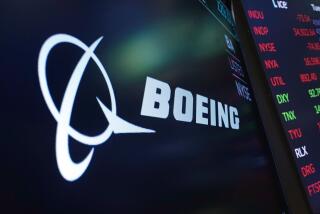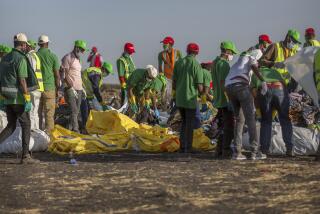Jury Gets Cerritos Air Disaster Case : Victims’ Lawyers Attempt to Blame Controller in 82 Deaths
The complex case stemming from the 1986 midair collision over Cerritos--the worst air disaster in Los Angeles County history--went to a federal court jury Friday, after an attorney for the Federal Aviation Administration argued that air traffic controller Walter White was not to blame for the tragedy that killed 82 people.
Justice Department attorney Steven J. Riegel contended that White could not have prevented the collision between an Aeromexico DC-9 and a small plane because the plane’s pilot, William K. Kramer, 53, had “blundered” into restricted airspace reserved only for jetliners approaching Los Angeles International Airport. Riegel also said the small plane’s pilot did not advise White of his position.
“All he (Kramer) had to do was pick up the microphone (and talk),” Riegel said in his closing argument.
White’s role in the tragedy had been debated by opposing sides during three days of closing arguments that ended Friday in U.S. District Court over who was to blame for the accident.
Clear Morning
The FAA blames Kramer and the Aeromexico pilot and co-pilot for the crash, arguing that they failed to look out for one another on that clear Sunday morning on Aug. 31, 1986.
But lawyers for the crash victims have contended that White was to blame. They say he should have spotted the small Piper Archer piloted by Kramer on his radar screen before it slammed into the tail of Aeromexico Flight 498.
Several expert witnesses testified during the 4 1/2-month trial that data stored in FAA computers show that Kramer’s plane was visible during 62 of 64 radar sweeps on White’s screen in the last minutes before the collision occurred at 11:52 a.m. and that he should have issued a traffic advisory to Flight 498.
White testified last December, however, that he did not see Kramer’s plane on his radar scope.
In his final argument Friday, Riegel said White could not have prevented the accident because Kramer’s plane was not on his radar scope. White, 37, now a FAA tower supervisor at the Santa Barbara Airport, was doing his job, directing aircraft authorized to be in the terminal control area (TCA) when the collision occured.
“It’s a little like saying to a police officer, ‘Why didn’t you stop that terrible rape and robbery?’ and he says, ‘I was a block away writing a speeding ticket,’ ” Riegel said.
Several plaintiffs’ attorneys had focused on White in the final days of the trial, hoping to persuade the jury to assess major liability against the FAA. Under federal law, however, the jury verdict in this case will be binding only on Kramer’s estate. U.S. District Judge David V. Kenyon has the power to set liability against the FAA and the airline company.
Once liability in the case is determined, the same formula will guide any later settlements.
“The equipment worked. The system worked,” attorney Joseph T. Cook said earlier this week. “But the human link failed. That is why 82 people lost their lives and why this courtroom is filled with grieving relatives.”
Co-counsel William Marshall Morgan added that White went into a “denial mode” and steadfastly contended that the small aircraft never appeared on his scope.
“He said ‘Oh no!’ (then) and continues to say ‘Oh no!’ to this day,” Morgan said. “He can’t hide behind that denial.”
In focusing on White and the FAA, the plaintiffs’ attorneys, for the most part, ignored the fact that Kramer’s plane was not where it was supposed to be.
The reason for the strategy, attorneys for both sides agree, is that the federal government can afford to pay settlements into the millions of dollars. Kramer left a $1-million estate, but it would not begin to cover the $100 million in damages that could be awarded in the case.
Limited Liability
In addition, Aeromexico is limited to a $75,000 settlement for each dead passenger under the 1929 Warsaw Convention that limits international carriers’ liability in such cases. The limitation, however, does not apply to the 15 people on the ground who died when fiery debris from the plane rained down on them.
If it is determined that the FAA is even 1% liable, the U.S. government could pay out millions to settle the more than 50 lawsuits stemming from the crash.
“Everybody’s gunning for us,” Riegel said.
Chicago lawyer George Archer, who is representing relatives of the Aeromexico crew, said the FAA should assume total blame for the accident.
“I don’t think it (FAA liability) should be 90%, 95% or even 99.4%,” he said. “It should be 100%. It’s that kind of a case.”
Riegel asked the jury to assess 80% liability to Kramer and 20% to Aeromexico for the pilots’ failure to avoid each other.
The jury is expected to begin deliberations Monday.
More to Read
Sign up for Essential California
The most important California stories and recommendations in your inbox every morning.
You may occasionally receive promotional content from the Los Angeles Times.










